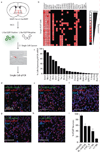Acute engagement of Gq-mediated signaling in the bed nucleus of the stria terminalis induces anxiety-like behavior
- PMID: 27956747
- PMCID: PMC5468515
- DOI: 10.1038/mp.2016.218
Acute engagement of Gq-mediated signaling in the bed nucleus of the stria terminalis induces anxiety-like behavior
Abstract
The bed nucleus of the stria terminalis (BNST) is a brain region important for regulating anxiety-related behavior in both humans and rodents. Here we used a chemogenetic strategy to investigate how engagement of G protein-coupled receptor (GPCR) signaling cascades in genetically defined GABAergic BNST neurons modulates anxiety-related behavior and downstream circuit function. We saw that stimulation of vesicular γ-aminobutyric acid (GABA) transporter (VGAT)-expressing BNST neurons using hM3Dq, but neither hM4Di nor rM3Ds designer receptors exclusively activated by a designer drug (DREADD), promotes anxiety-like behavior. Further, we identified that activation of hM3Dq receptors in BNST VGAT neurons can induce a long-term depression-like state of glutamatergic synaptic transmission, indicating DREADD-induced changes in synaptic plasticity. Further, we used DREADD-assisted metabolic mapping to profile brain-wide network activity following activation of Gq-mediated signaling in BNST VGAT neurons and saw increased activity within ventral midbrain structures, including the ventral tegmental area and hindbrain structures such as the locus coeruleus and parabrachial nucleus. These results highlight that Gq-mediated signaling in BNST VGAT neurons can drive downstream network activity that correlates with anxiety-like behavior and points to the importance of identifying endogenous GPCRs within genetically defined cell populations. We next used a microfluidics approach to profile the receptorome of single BNST VGAT neurons. This approach yielded multiple Gq-coupled receptors that are associated with anxiety-like behavior and several potential novel candidates for regulation of anxiety-like behavior. From this, we identified that stimulation of the Gq-coupled receptor 5-HT2CR in the BNST is sufficient to elevate anxiety-like behavior in an acoustic startle task. Together, these results provide a novel profile of receptors within genetically defined BNST VGAT neurons that may serve as therapeutic targets for regulating anxiety states and provide a blueprint for examining how G-protein-mediated signaling in a genetically defined cell type can be used to assess behavior and brain-wide circuit function.
Conflict of interest statement
The authors declare no conflict of interest.
Figures





References
-
- Kessler RC, Berglund P, Demler O, Jin R, Merikangas KR, Walters EE. Lifetime Prevalence and Age-of-Onset Distributions of DSM-IV Disorders in the National Comorbidity Survey Replication. Arch Gen Psychiatry. 2005 Jun 1;62(6):593. - PubMed
-
- Insel TR. Next-generation treatments for mental disorders. Sci Transl Med. 2012 Oct 10;4(155):155ps19. - PubMed
Publication types
MeSH terms
Substances
Grants and funding
- K01 AA023555/AA/NIAAA NIH HHS/United States
- P60 AA011605/AA/NIAAA NIH HHS/United States
- R56 DA015446/DA/NIDA NIH HHS/United States
- P30 DK034987/DK/NIDDK NIH HHS/United States
- F31 AA023440/AA/NIAAA NIH HHS/United States
- T32 DA007135/DA/NIDA NIH HHS/United States
- P50 AA011605/AA/NIAAA NIH HHS/United States
- T32 AA007573/AA/NIAAA NIH HHS/United States
- R01 DA015446/DA/NIDA NIH HHS/United States
- R01 MH097988/MH/NIMH NIH HHS/United States
- T32 MH076694/MH/NIMH NIH HHS/United States
- R21 MH080935/MH/NIMH NIH HHS/United States
- R01 DA033660/DA/NIDA NIH HHS/United States
- R01 DA030359/DA/NIDA NIH HHS/United States
- R01 AA019454/AA/NIAAA NIH HHS/United States
- U01 MH105892/MH/NIMH NIH HHS/United States
- U01 AA020911/AA/NIAAA NIH HHS/United States
LinkOut - more resources
Full Text Sources
Other Literature Sources
Medical

